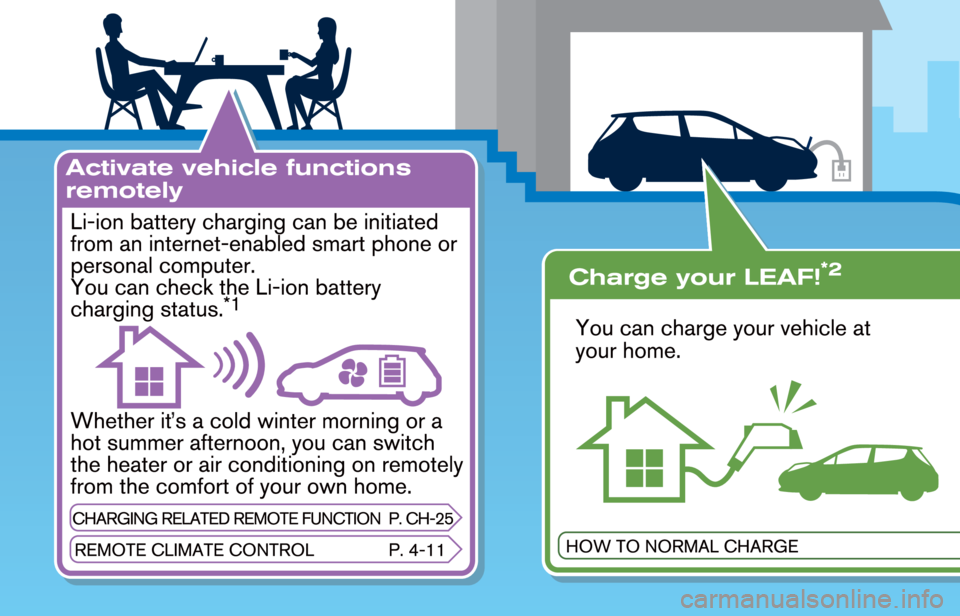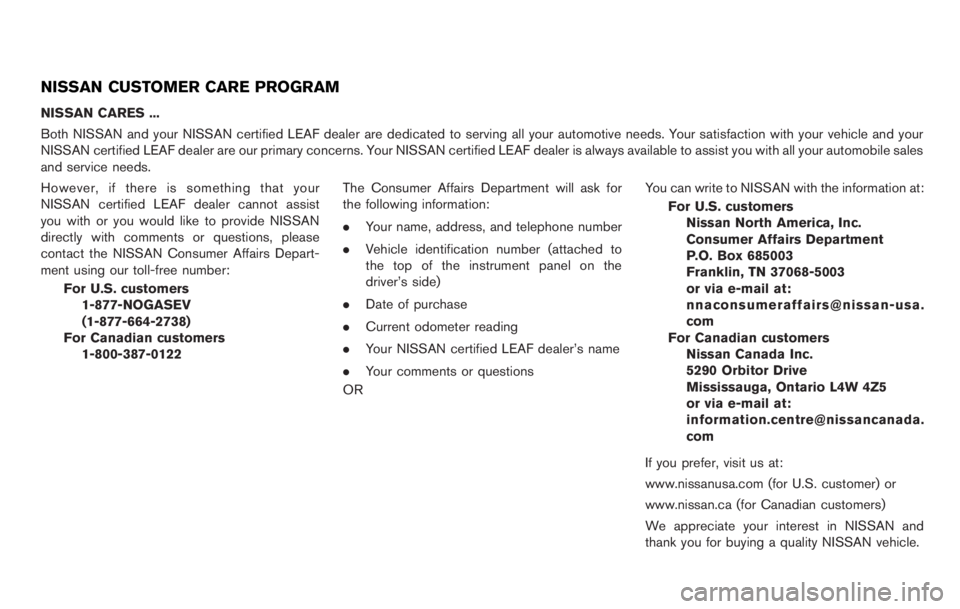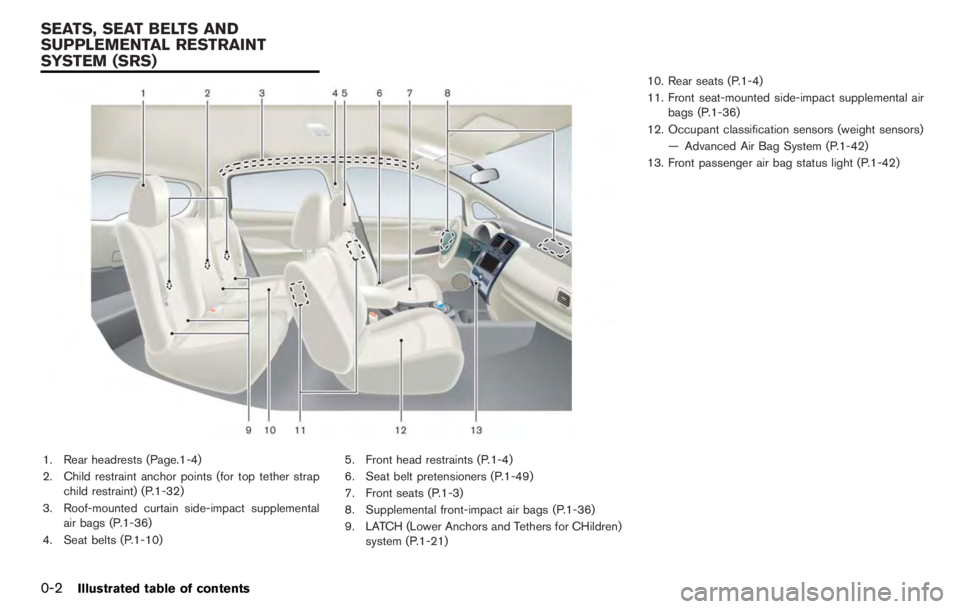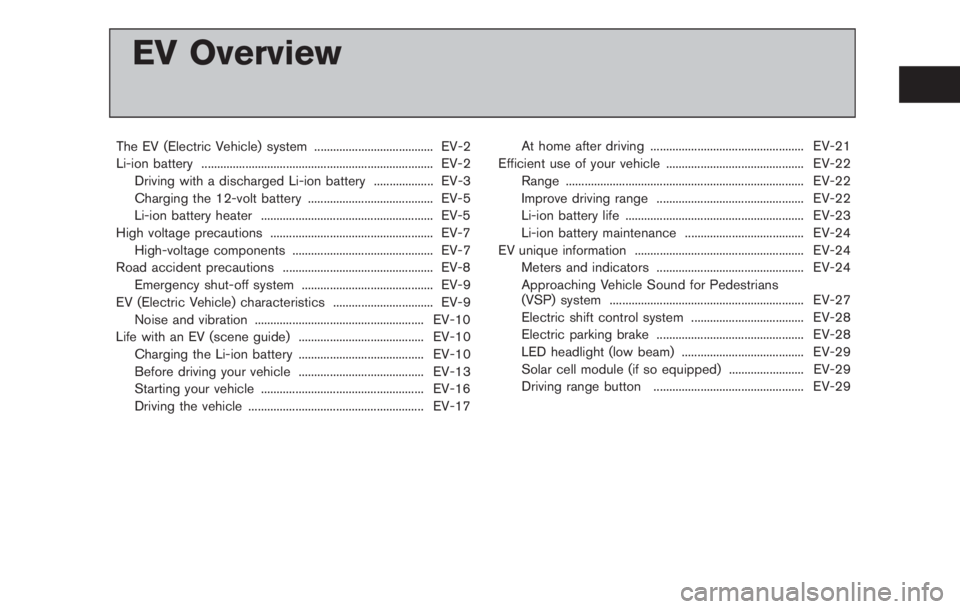2012 NISSAN LEAF brake
[x] Cancel search: brakePage 3 of 1062

Do not allow the two vehicles to touch.
2. Apply the parking brake.
If the 12-volt battery is discharged, the
power switch cannot be moved from
the OFF position. Connect the jumper
cables to the booster vehicle
*Bbefore
pushing the power switch.
3. Push the P position switch to place the vehicle in the P (Park) position.
4. Switch off all unnecessary electrical systems (headlights, heater, air conditioner, etc.).
5. Place the power switch in the OFF position.
6. Remove the vent caps on the 12-volt battery (if so equipped) . Cover the battery with a
firmly wrung out moist cloth to reduce the
hazard of an explosion.
7. Connect jumper cables in the sequence as illustrated (
*1?*2?*3?*4).
Page 8 of 1062

.Never tow a vehicle using the vehi-
cle tie down hook or recovery hook.
. Always pull the cable straight out
from the front of the vehicle. Never
pull on the vehicle at an angle.
. Pulling devices should be routed so
they do not touch any part of the
suspension, steering, brake or cool-
ing systems.
. Pulling devices such as ropes or
canvas straps are not recommended
for use in vehicle towing or recov-
ery.
Rocking a stuck vehicle
If the vehicle is stuck in sand, snow, mud, etc.,
try to free it by following the procedure below.
1. Turn off the Vehicle Dynamic Control (VDC)
system.
2. Make sure the area in front and behind the vehicle is clear of obstructions.
3. Turn the steering wheel left and right to clear an area around the front tires.
4. Slowly rock the vehicle forward and back- ward.
.Shift back and forth between the R
(Reverse) and D (Drive) positions.
.Apply the accelerator as little as possible
to maintain the rocking motion.
.Release the accelerator pedal before
shifting between R and D.
.Do not spin the tires above 35 MPH (55
km/h).
5. If the vehicle cannot be freed after a few tries, contact a professional towing service
to remove the vehicle.
Page 9 of 1062

If the electric parking brake cannot be released
by operating the electric parking brake switch,
the parking brake can be mechanically released.
Note that the following procedure must be
performed only when the parking brake needs
to be released in an emergency.
NOTE:
.Depending on the type of parking
brake system malfunction, the parking
brake switch operation indicator may
blink and the electric shift control
system warning light may illuminate in
the meter.
. If the electric shift control system
warning light illuminates in the meter,
stop the vehicle in a safe location and
contact a NISSAN certified LEAF dealer
immediately.
. The mechanical release of the parking
brake should only be done if there is a
malfunction of the electric parking
brake system. After the parking brake
mechanical release has been done, the
vehicle needs to be repaired. Have your
vehicle inspected by a NISSAN certified
LEAF dealer.
To release the parking brake mechanically,
perform the following procedure. 1. Confirm that the vehicle is in the P (Park)
position. If the vehicle cannot be placed in
the P (Park) position, contact a NISSAN
certified LEAF dealer.
2. Check that the parking brake switch opera- tion indicator does not illuminate.
3. Place power switch in the OFF position.
4. Open the rear hatch.
5. Remove the tool for mechanical release from the tool set that is located in the cargo area.
6. Remove the luggage floor board from the cargo area.
7. Remove the cap by turning counterclock- wise.
8. Insert the tool and turn it counterclockwise while pushing it in.
9. Continue to turn it until it stops and then release your hand. The tool will then return
approximately the same position it was in
before it was turned and release of the
parking brake will be completed. Do not turn
the tool beyond the point at which it stops.
Doing so may result in damage.
10. Store the tool for mechanical release by performing the procedure for removing it in
reverse.
Page 10 of 1062

.If the vehicle is driven with the
electric parking brake applied, the
electric brake components may
overheat causing a deterioration in
electric parking brake effectiveness
and premature electric parking
brake wear.
. The electric parking brake mechan-
ical release tool should be used
only to release the electric parking
brake in an emergency.
NOTE:
The electric parking brake mechanical
release tool can only be used to release
the electric parking brake. It can not to be
used to apply the electric parking brake.
The electric parking brake operation
switch indicator may turn off 1 minute
after the power switch is placed in the OFF
position. If the parking brake switch op-
eration indicator does not turn off, contact
a NISSAN certified LEAF dealer.
Page 15 of 1062

5 Starting and driving
Precautions when starting and driving ............................... 5-2Tire Pressure Monitoring System (TPMS) ................... 5-2
Avoiding collision and rollover ........................................ 5-5
Off-road recovery ............................................................... 5-5
Rapid air pressure loss ..................................................... 5-5
Drinking alcohol/drugs and driving ................................ 5-6
Push-button power switch .................................................... 5-7 Intelligent Key system ....................................................... 5-7
Operating range for EV (Electric Vehicle)
start function ........................................................................ 5-8
Power switch operation .................................................... 5-8
Power switch positions ..................................................... 5-9
Emergency EV (Electric Vehicle) shut off .................... 5-9
Intelligent Key battery discharge ................................. 5-10
Before starting the EV (Electric Vehicle) system .......... 5-10
Starting the EV (Electric Vehicle) system ....................... 5-11
Driving vehicle ........................................................................ 5-11 Electric shift control system ......................................... 5-11
Electric parking brake .......................................................... 5-15 Cruise control ........................................................................ 5-17
Precautions on cruise control .................................... 5-17Cruise control operation ............................................. 5-17
Increasing power economy ................................................ 5-19 Parking/parking on hills ....................................................... 5-20
Electric power steering system ........................................ 5-21
Brake system ......................................................................... 5-21 Braking precautions ..................................................... 5-21
Electric parking brake break-in .................................. 5-23
Anti-lock Braking System (ABS) .............................. 5-23
Vehicle Dynamic Control (VDC) system ........................ 5-24
Cold weather driving ........................................................... 5-26 Freeing a frozen door lock .......................................... 5-26
Antifreeze ........................................................................ 5-26
12-volt battery ................................................................ 5-26
Draining of coolant water ............................................ 5-26
Tire equipment ............................................................... 5-27
Special winter equipment ........................................... 5-27
Driving on snow or ice ................................................ 5-27
Freeing a frozen charge port lid ................................ 5-27
Page 18 of 1062

.Do not place metalized film or any
metal parts (antenna, etc.) on the
windows. This may cause poor re-
ception of the signals from the tire
pressure sensors, and the TPMS will
not function properly.
Some devices and transmitters may temporarily
interfere with the operation of the TPMS and
cause the low tire pressure warning light to
illuminate. Some examples are:
. Facilities or electric devices using similar
radio frequencies that are near the vehicle.
. If a transmitter set to similar frequencies is
being used in or near the vehicle.
. If a computer (or similar equipment) or a DC/
AC converter is being used in or near the
vehicle.
FCC Notice:
For USA:
This device complies with Part 15 of the
FCC Rules. Operation is subject to the
following two conditions: (1) This device
may not cause harmful interference, and
(2) this device must accept any interfer-
ence received, including interference that
may cause undesired operation. NOTE:
Changes or modifications not expressly
approved by the party responsible for
compliance could void the user’s authority
to operate the equipment.
For Canada:
This device complies with RSS-210 of
Industry Canada. Operation is subject to
the following two conditions: (1) this
device may not cause interference, and
(2) this device must accept any interfer-
ence, including interference that may
cause undesired operation of the device.
TPMS with Easy Fill Tire Alert
When tire pressure is low, the low tire pressure
warning light illuminates.
This vehicle provides visual and audible signals
to help you inflate the tires to the recommended
COLD tire pressure.
Vehicle set-up:
1. Park the vehicle in a safe and level place.
2. Apply the parking brake and push the P
position switch on the selector lever.
3. Place the power switch in the ON position. Do not place in the READY to drive mode. Operation:
1. Add air to the tire.
2. After a few seconds, the hazard indicators
will start flashing.
3. When the designated pressure is reached, the horn beeps once and the hazard
indicators stop flashing.
4. Perform the above steps for each tire.
. If the tire is over-inflated more than approxi-
mately 4 psi (30 kPa), the horn beeps and
the hazard indicators flash 3 times. To
correct the pressure, push the core of the
valve stem on the tire briefly to release
pressure. When the pressure reaches the
designated pressure, the horn beeps once.
. If the hazard indicator does not flash within
approximately 15 seconds after starting to
inflate the tire, it indicates that the Easy Fill
Tire Alert is not operating.
. The TPMS will not activate the Easy Fill Tire
Alert under the following conditions:
— If there is interference from an external
device or transmitter.
— The air pressure from the inflation device is not sufficient to inflate the tire such as
those using a power socket.
Page 23 of 1062

10 Index
A
ABS (Anti-lock Braking System) ............................ 5-23
Advanced air bag system ......................................... 1-42
Air bag systemAdvanced air bag system .................................. 1-42
Front passenger air bag and status light....... 1-44
Front-seat mounted side-impact supplemental
air bag system....................................................... 1-47
Roof-mounted curtain side-impact
supplemental air bag system ............................ 1-47
Air bag warning labels............................................... 1-50
Air bag warning light...................................... 1-50, 2-18
Air conditioner Air conditioner specification label....................... 9-8
Air conditioning system refrigerant and
lubricant recommendations................................... 9-3
Alarm, How to stop alarm (see vehicle
security system)........................................................... 2-36
Alcohol, drugs and driving.......................................... 5-6
Anti-lock Braking System (ABS) ............................ 5-23
Anti-lock braking system (ABS) warning light..... 2-14
Appearance care Exterior appearance care ...................................... 7-2
Interior appearance care ....................................... 7-4
Audible reminders....................................................... 2-21
Autolight system.......................................................... 2-42
Automatic Door locks................................................................. 3-5
Automatic climate control ........................................... 4-6
Avoiding collision and rollover ................................... 5-5
B
Battery 12-volt battery....................................................... 8-11
Battery saver system........................................... 2-43
Intelligent Key battery.......................................... 8-18
Li-ion battery.......................................................... EV-2
Li-ion battery temperature gauge........................ 2-7
Before starting system............................................... 5-10
Booster seats............................................................... 1-33
Brake Anti-lock Braking System (ABS) ..................... 5-23
Brake fluid................................................................. 8-9
Brake system......................................................... 5-21
BRAKE system warning light (yellow) ............ 2-14
BRAKE warning light (red) ................................ 2-15
Brakes..................................................................... 8-15
Electric parking brake operation ...................... 5-15
BRAKE system warning light (yellow) ................... 2-14
BRAKE warning light (red) ....................................... 2-15
Bulb replacement........................................................ 8-20
C
Cabin air filter............................................................... 4-13
Capacities and recommended lubricants ............... 9-2
Cargo cover.................................................................. 2-51
Ceiling light................................................................... 2-57
Charging Charge port lid...................................................... 3-17
Charging related indicator light.................... CH-26
Charging timer .................................................. CH-19
Cleaning .................................................................... 7-6
Normal charge ..................................................... CH-9
Precautions on charging ................................... CH-2 Quick charge..................................................... CH-16
Specifications........................................................... 9-4
Tricklle charge................................................... CH-11
Charging methods .................................................. CH-19
Charging related indicator light........................... CH-26
Charging related remote function....................... CH-25
Charging status indicator light ............................ CH-26
Charging timer ......................................................... CH-19
Charging troubleshooting guide.......................... CH-30
Checking Checking bulbs..................................................... 2-13
Checking coolant level .......................................... 8-8
Child restraints............................................................. 1-19 Booster seats........................................................ 1-33
Precautions on child restraints......................... 1-19
Top tether strap.................................................... 1-22
Child safety................................................................... 1-17
Child safety rear door lock ......................................... 3-6
Circuit breaker, Fusible link...................................... 8-17
Cleaning exterior and interior............................ 7-2, 7-4
Climate control Climate control service....................................... 4-14
Climate control system refrigerant and
lubricant recommendations................................ 4-14
In-cabin microfilter ............................................... 4-13
Climate control system Climate control operation...................................... 4-3
Climate Ctrl. Timer........................................................ 4-7
Clock.............................................................................. 2-11
Cockpit ............................................................................ 2-3
Cold weather driving.................................................. 5-26
Console box ................................................................. 2-51
Coolant Capacities and recommended lubricants ......... 9-2
Changing coolant.................................................... 8-8
Page 24 of 1062

Checking coolant level .......................................... 8-8
Cooling system.............................................................. 8-7
Corrosion protection .................................................... 7-7
Cruise control............................................................... 5-17
Cup holders.................................................................. 2-49
D
Defroster switch, Rear window and outside mirror
defroster switch........................................................... 2-40
Dimensions and weights............................................. 9-5
Dot matrix liquid crystal display............................... 2-22
Driving Cold weather driving........................................... 5-26
Driving vehicle....................................................... 5-11
Precautions when starting and driving .............. 5-2
Driving range.................................................................. 2-8
Driving vehicle.............................................................. 5-11
E
ECO indicator.............................................................. 2-10
Efficient use of your vehicle ................................. EV-22
Electric parking brake break-in................................ 5-23
Electric parking brake indicator light...................... 2-19
Electric power steering system ............................... 5-21
Emergency charge.................................................. CH-11
Emergency EV (Electric Vehicle) shut off...... 5-9, 6-2
Emergency shutoff system........................................ EV-9
Emission control information label............................ 9-7
EV Characteristics ..................................................... EV-9
EV system ..................................................................... EV-2
EV unique information............................................. EV-24
Event Data Recorder (EDR)..................................... 9-18
EVSE (Electric Vehicle Supply Equipment) ..... CH-11
EVSE (Electric Vehicle Supply
Equipment) cleaning..................................................... 7-6
F
F.M.V.S.S./C.M.V.S.S. certification label ................. 9-7
Flashers (See hazard warning flasher switch)..... 2-45
Flat tire............................................................................. 6-2
Flat towing .................................................................... 9-14
Floor mat cleaning ........................................................ 7-5
Fluid Brake fluid................................................................. 8-9
Capacities and recommended lubricants ......... 9-2
coolant ....................................................................... 8-7
Reduction gear fluid............................................... 8-9
Window washer fluid .......................................... 8-10
Fog light switch........................................................... 2-44
Front manual seat adjustment.................................... 1-3
Front passenger air bag and status light.............. 1-44
Front seat, Front seat adjustment............................. 1-3
Fuses.............................................................................. 8-16
Fusible links.................................................................. 8-17
G
Garage door open, HomeLink®Universal
Transceiver............................................................. 2-58
Gauge .............................................................................. 2-5 Driving range............................................................ 2-8
ECO indicator....................................................... 2-10
Li-ion battery available charge gauge................ 2-9
Li-ion battery capacity level gauge.................. 2-10
Li-ion battery temperature gauge........................ 2-7
Odometer.................................................................. 2-6
Power meter ............................................................. 2-7
Speedometer............................................................ 2-6
General maintenance ................................................... 8-2
Glove box...................................................................... 2-51
H
Hazard warning flasher switch................................. 2-45
Head restraints .............................................................. 1-4
Headlights Bulb replacement................................................. 8-21
Headlight Aiming Control ................................. 2-44
Headlight switch................................................... 2-41
Heated seats................................................................ 2-46
Heated steering wheel............................................... 2-45
High voltage precautions .......................................... EV-7
HomeLink
®universal transceiver............................. 2-58
Hood release................................................................ 3-16
Horn................................................................................ 2-46
How to normal charge.............................................. CH-9
How to quick charge.............................................. CH-16
How to trickle charge ............................................ CH-11
I
If the Li-ion battery becomes
completely discharged............................................... 6-12
Immediate charge.................................................... CH-24
Immobilizer system...................................................... 2-36
In-cabin microfilter ...................................................... 4-13
indicator Electric parking brake indicator light............... 2-19
Indicator lights.............................................................. 2-19
Indicators for operation.............................................. 2-23
Inside rearview mirror................................................. 3-20
Instrument brightness control .................................. 2-41
Instrument panel............................................................ 2-4
Intelligent Key system ......................................... 3-6, 5-7 Key operating range ............................................... 3-8
Key operation ........................................................ 3-10
Remote keyless operation.................................. 3-13